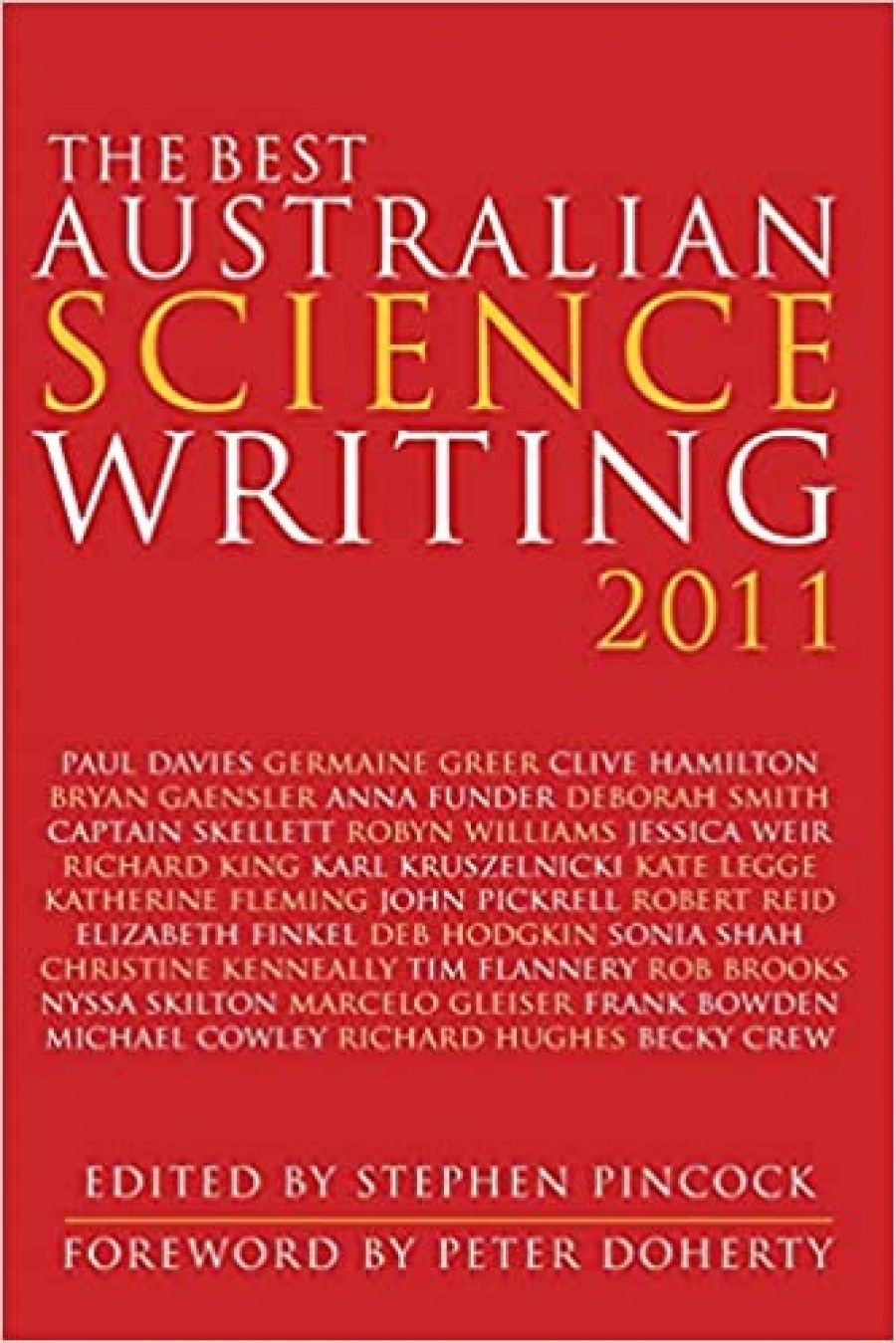
- Free Article: No
- Contents Category: Anthology
- Review Article: Yes
- Online Only: No
- Custom Highlight Text:
It is a brave editor who compiles a paper-based anthology of science writing in the age of the Internet. Electronic publishing allows the skilful juxtaposition of text and image, with the added value of links that lead the viewer to instantly available extra information. With Stephen Pincock’s print anthology The Best Australian Science Writing 2011, I am nostalgically transported to the nineteenth century, where Charles Darwin and Thomas Huxley brought their science to the people in discursive essay form.
- Book 1 Title: The Best Australian Science Writing 2011
- Book 1 Biblio: New South, $29.95 pb, 222 pp
Not that there is anything wrong with the leisurely essay. It works very well for some topics in this anthology: for example, Elizabeth Finkel on ‘The Trouble with Genes’. Finkel tackles a conceptual issue of interest to anyone whose knowledge of biology is so dated: what is the current definition of the gene? Where once the confident reply might have been that a gene is a discrete element for a particular protein, Finkel finds herself in muddier waters; now ‘genetic information is multilayered’. Finkel does the science writer’s thing: she interviews the experts, asks good questions that the reader might ask, if only the reader knew more, adds some history of science, and deals well with difficult topics such as the nature of ‘junk’ DNA.
Pincock, of course, is well aware of the value of online science communication. Nine of the twenty-seven articles in the anthology originated on the Internet. Four come from sources in the exemplary Science Unit of the Australian Broadcasting Corporation. Five articles first appeared on science blogs. The anthology print version, however, often offers the reader less than the online version. Some articles translate well, such as ‘There Is No Mercury in Vaccines’ by Deb Hodgkin, drawn from her blog: Science@home. The reader gets a clear, demystified, pro-vaccination message. The online version offers more, in instant links to four related articles.
Print publication works less well with Becky Crew’s article ‘You Should Probably Just Move Oceans, Male Gulf Pipefish’. In the blog version, the viewer may link to an eight-minute video in which the researchers themselves present their findings to the public. In the video, we see the three aims of Pincock’s anthology exemplified: explanations of new findings (here by the scientists themselves); descriptions of the process of science; the place of science in culture. Unfortunately, the print version suffers from the omission of much of this material. Crew takes a throwaway line from one researcher on what a male pipefish might find sexually attractive in a female, and does a bar-room riff on an after-sex encounter between the pipefish pair. It is fun, it makes its point, and no doubt it will galvanise a class of Year Nine students into discussion. But the original online version provides more relevant context.
Using sex to grab the reader’s attention is an old ploy. But why, as so often in talk about sexual selection, is it always about what an individual male finds attractive in the female? How can any researcher know how a (male) fish might perceive (female) ugliness? For a similar reason, I get twitchy with claims made by Rob Brooks in the extract from his book Sex, Genes and Rock ’n’ Roll: How Evolution has Shaped the Modern World (2011). I am fascinated by the importance of music in human evolution, and the extract makes me want to read the book, but the article is also irritating. Brooks explores rock’n’roll as an example of male sexual display. The hook for the reader is the assumed superior reproductive fitness of members of the Rolling Stones, because three of its members collectively fathered at least sixteen children by many women. Why in the year 2011 still write as if the female is the passive recipient of those great male genes, when the female also contributes her equal genetic half to the process (Biology 101)? When Brooks adds, ‘If ancient musicians enjoyed even a fraction of the mating success of modern rock stars’, he gives me room to counter, ‘Ancient musicians did it better’. The family of J.S. Bach is a much better illustration of possible linked biological and cultural components to musical ability. Bach fathered twenty children by two mothers. Both mothers, Anna Barbara and Anna Magdalena, were musically literate. Four of the ten Bach children who survived to adulthood were noted composers and performers. There may be a book in it: Sex, Genes, and Solemn Church Music.
There is much to admire in this anthology: articles by Robyn Williams on the typology of anti-science ratbags; Clive Hamilton on the pressing importance of evidence-based climate science; Paul Davies on the search for extraterrestrial intelligence; Deborah Smith on rhinoceros IVF. If one aim is to reach out to secondary school students, this book provides an ideal place for them to start before hitting the Internet. I would particularly recommend the one social science article in the anthology, ‘It’s Time to Talk’ by Kate Legge, on the topic of youth suicide. Legge combines personal reflection with interviews that integrate seamlessly into her argument. She builds the case for an end to the suppression of media reports on suicide, arguing that there is evidence that it doesn’t work as intended, and that better community awareness may save lives.


Comments powered by CComment